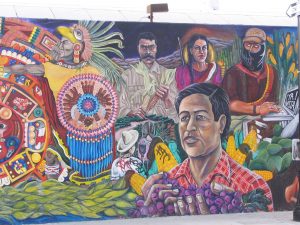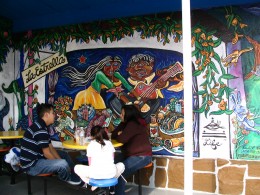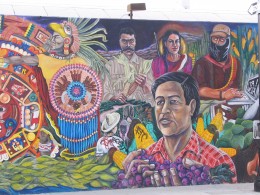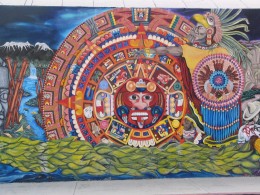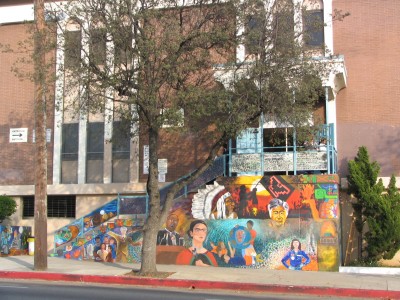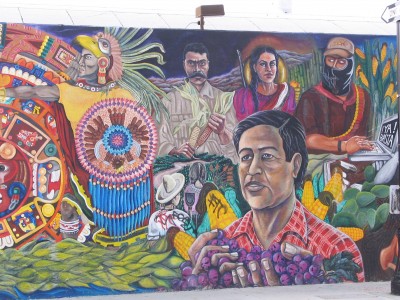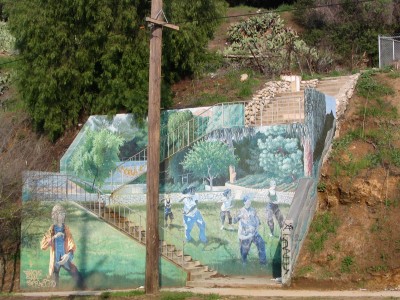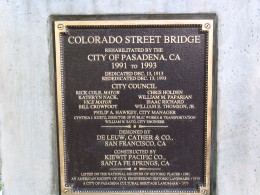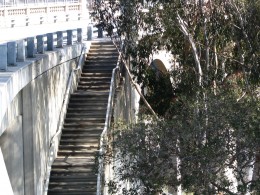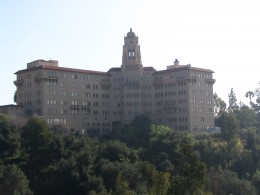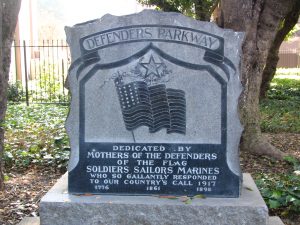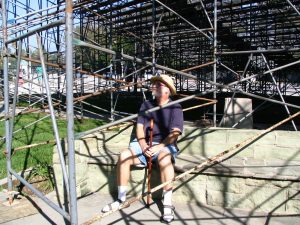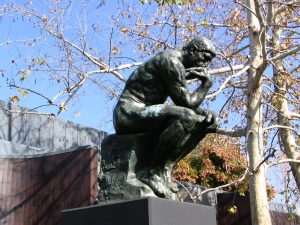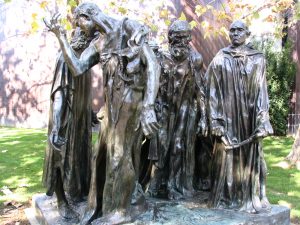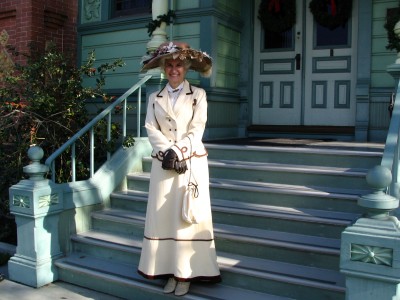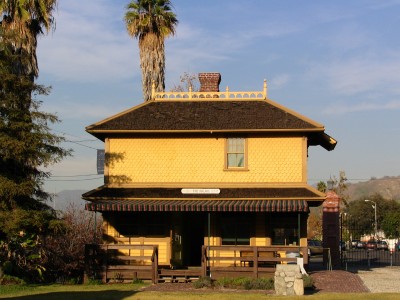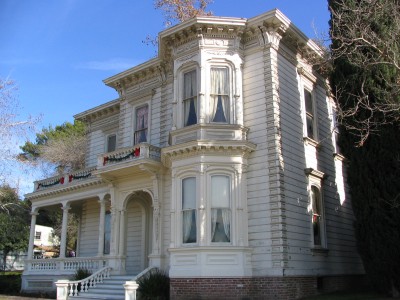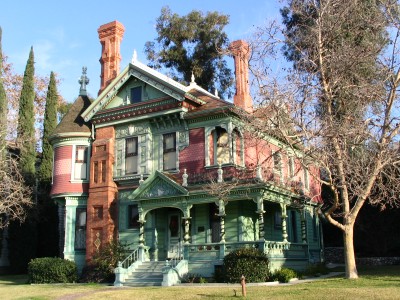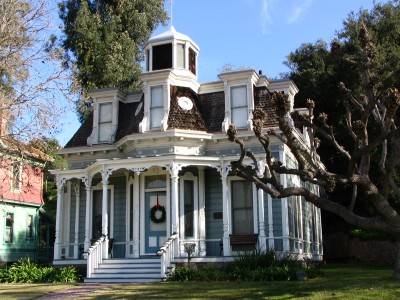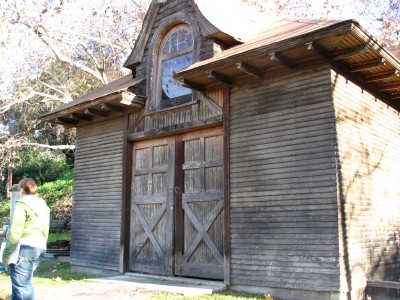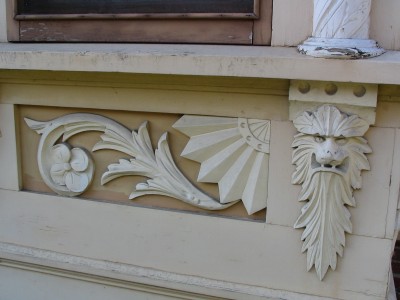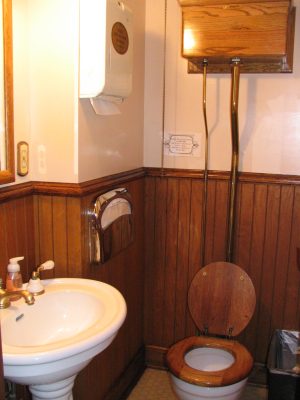Figueroa Street again. Yet another neighborhood where English is definitely the minority language. On this stretch the Metro Gold Line seems to have revitalized the area a bit, as these things tend to do. But south of the main street the houses are larger, and north, lining the tracks, and some quite small ones. Once again, a neighborhood rich in murals. After a while you begin to notice a few familiar themes running through them. Aztecs are popular, as are Mayas and Incas. Cesar Chavez is usually in there somewhere, and some fierce-looking brown-skinned revolutionaries carrying AK-47s. Che Guevara doesn’t show up quite as much as I’d expect. Maybe he’s no longer fashionable.
We passed by one of the nicer-looking schools. There is an entryway with a series of murals and a mosaic banner: FRUIT AND FLOWER SHOW THE MAGIC OF HIS MIND. I took a wild guess … Luther Burbank? Bingo! While Lee was photographing some of the myriad murals, I was taking a closer look at them. There was a wall with the theme of what looked like a Chinese garden and building, but a Japanese rising sun. Asian, anyway. There was another that showed Africans, Arabs, sand dunes, a camel. Another had Mexicans, present-day and Aztec. In the front there was a six-paneled painting showing mankind’s achievements. Yet another showed Chavez, Frida Kahlo (and you notice, a few years ago you’d never heard of her, now you can’t avoid her?), Martin Luther King, Jr. … a long list of historical accomplishments. But something seemed to be missing and I finally put my finger on what it was. Caucasians. White folks. You know, people who look like me. Wait, there he is! Luther Burbank! A white guy! Well, they could hardly have excluded him from this school, right?
Now, I’m not completely sure what I intend to say here. I certainly am no advocate for white power, white identity, any of that crapola. I looked around at the students I could see and sure enough, I’d say about 80% Hispanic, with much of the rest various Asian races, a few black kids … and a few white kids. I’m all in favor of positive role models for these majority kids, and I doubt the white kids really feel the lack of people who look like themselves. This is still a country run by whites, after all. Still … is it a good idea just to edit white people out of the march of American civilization? Pretend we never existed? Couldn’t we have just one little mural panel, even if it’s only showing Custer’s Last Stand? I’d settle for that. Don’t forget, we white people had to kill a whole bunch of Indians to settle this land from sea to shining sea … and while we were moving from the north and east, the Spaniards were killing plenty as they moved from the south. Don’t we at least get some credit for that? (I’m kidding. I think.) To this day, most of the tiny, broad-faced, poorest Mexicans and Mexican-Americans you see in Los Angeles are clearly mestizo, partly or mostly Indian. There’s racism south of the border, too.
There’s a lovely new branch of the library here, the Arroyo Seco branch, built with an exterior of native river rock. I can’t say enough about the Los Angeles library system. There are 71 branches, and all the ones I’ve visited seem to get a lot of use. The main library downtown has risen like a phoenix from the ashes of the catastrophic arson fire in 1986 and is now a showplace, with its Egyptian theme and amazing murals and mosaics. This is the third-largest public library in the US, and has what is probably the world’s greatest collection of movie memorabilia. My own neighborhood branch, the Francis Goldwyn/Hollywood Regional, reopened just two years ago after an extensive renovation. Los Angeles still seems willing to spend money on its libraries; I hope that continues with the tax crunch the state and county is facing.
One thing area taxpayers aren’t spending money on, it seems, are street lights. About half the poles we passed had signs on them: STREETLIGHT OUT OF SERVICE (ASSESSMENTS DEFEATED). Then it gives you a number for the Los Angeles Bureau of Street Lighting … and it’s been disconnected. This seems short-sighted to me. What are they going to do when they all burn out? Carry torches? This sort of thing can kill a neighborhood.
Over the last hill, and down into Eagle Rock and Colorado Boulevard. At the top of the hill was the last major mural, something called Tai Chi Eagle Rock. It had been a long walk, and now it was time to go home.
Next day, a short walk took us into Pasadena. I’m afraid it was a pretty boring day, for the most part. We were soon going along beside the 134 and then the 210 freeways, nothing to see to the north, a series of streets going off to the south. Some of the streets were lined with ordinary middle class homes, but soon we were into a neighborhood of real mansions and estates. We had to dodge two barking dogs that were on the loose—just about the first time that dogs have been a problem on our walks. Then we were approaching the historic old Colorado Street Bridge, which for some reason was blocked off by the police, to vehicle traffic, anyway. The motorcycle cop told us it was okay to walk across, though, so we did, and it was a nice way to see it. Much quieter than usual, though it’s never really quiet with the freeway not far to the north. We had excellent views of Arroyo Seco to the south, with a bit of fall color … or at least as much fall color as we ever get here in the sunny Southland. To the north we could just see the Rose Bowl. And to the east, there was the magnificent old building that used to be the Vista Del Arroyo Hotel, built in 1903, looking like it might be a hospital—and in fact, it was, during World War II. When we got there we were astonished to learn that it’s now the US Court of Appeals, Ninth Circuit. I don’t know if they have courtrooms there, it’s probably just endless federal paper shuffling, in very nice surroundings. Your taxpayer dollars at work, no doubt.
At the other end of the bridge there are various war memorials to various wars and, amazingly enough (I think this was the 12th of January), most of the temporary bleachers erected for the Tournament of Roses Parade, still standing, only starting to be disassembled. We studied them as possible seats for next year’s parade, when we hope my mom and sisters might come to Pasadena and watch with us.
Just beyond that is the Norton Simon Museum, which we’ve visited several times. They have an excellent collection of 19th Century and earlier art, and extensive Asian art, mostly sculpture. Outside in front, and free, is a selection of castings by Rodin, including The Thinker, Monument to Balzac, and The Burghers of Calais, one of my favorites. We’ll be visiting it again on the next free evening, in February, and will include it as a Route 66 side trip.
- The Thinker
- The Burghers of Calais
Across the entrance ramps to the 210 and we went by a very tony car dealership, selling just about all the really expensive European iron. Bentley, Jag, like that. We looked at a Rolls-Royce Saloon that was about the ugliest luxury car we’d ever seen. It had all the styling of a block of Philadelphia cream cheese … in fact, it looked like cheese, with a few windows carved out of it. It was massive, I’ll grant you that, but so is an Abrams tank. Price: $341,000. You could buy a nice house for that, some places. Two nice houses. And I’d take them. What the hell happened to Rolls? The old ones, you’re just in awe as they roll by, with that great grille and the flying lady. This thing, it was like they’d deliberately stamped out anything that might give it some character.
We had an excellent lunch at the Cheesecake Factory on the corner of Colorado and Fair Oaks … which, as it happens, is the intersection of Route 66 and Route 66. So now we have to go back south again and work our way north once more along Huntington Boulevard until we’re at this same spot again. See you then.
Side Trip – Heritage Square
Tucked away in a narrow cul-de-sac beside the Pasadena Freeway (you might almost say hidden) is one of the more obscure Los Angeles treasures. It’s only a short walk from Route 66, so we’re including it as a side trip. This is Heritage Square, where an assortment of architectural treasures have been moved and have either been restored or are awaiting restoration. It’s only open on the weekends. It’ll cost you $10 to get in, but it’s well worth it, as it includes a guided tour of the eight structures. Unfortunately, as in so many places these days, they don’t allow photography inside the houses so all we can show you is the outsides.
The tours leave hourly from the first building, which is the Palms Depot railroad station. It used to be in Culver City. There we were met by our guide, Natalie, and her trainee guide, Loren. Natalie was dressed in full period costume, which included (she informed us) about a dozen layers of undergarments and a steel-ribbed corset. There was only one other couple in this tour group. Natalie took us across the gravel road to the first house, which was:
The Perry Mansion. This is the oldest building here, built in 1876 (at the end of the Grant administration!) by William Perry, a lumber baron and the man who first brought gas lighting to Los Angeles. I have to keep remembering what a small city LA was back then. The building was being renovated to be turned into offices, complete with computer wiring, when the most recent LA quake almost destroyed it, or the interior, anyway. The developers threw up their hands in dismay, and donated the building to Heritage Square. They have now restored most of the damage, though they still plan to rip out most of the anachronistic wiring. They have their standards.
Hale House. The jewel of the collection, no question about it. It’s actually bigger than the “mansion” next door, but they haven’t been neighbors all that long. This one was moved, too, like all the buildings here, but this one only came a few blocks. They had to saw it in half, and disassemble the ornate chimneys brick by brick. And once they got it to the new site and re-built? Pow! Earthquake! The chimneys came a-tumbling down. When they rebuilt again they made them solid concrete, so they can’t be used, but they ought to stay up. With the building itself they have been fanatical with the details, finding paint chips of the original colors, and patches of wallpaper they could duplicate. (In the kitchen there is a picture of this house painted in 34 different colors. Turns out they let a paint company color it like that to advertise its new line of exterior glosses, on the condition that they’d strip it down when they were through and re-coat it in the original colors. So they got new paint job for free, and even made a little money on the side! Neat!) The rooms are simply jammed with furniture, in the Victorian manner, all of it from the proper period. The chandeliers overhead are unusual, in that they are equipped for both electricity and gas lighting. I guess the power wasn’t all that reliable back then. That, or they didn’t know if this newfangled electricity stuff was going to be around all that long. This is as good a job of restoration as I’ve ever seen.
Valley Knudsen Garden Residence. Doesn’t look like a Los Angeles building at all, with its Mansard roof. Upstairs (which we can’t see; fire laws prevent them from letting the public upstairs in any of these buildings) there is what’s called a “fainting room.” Natalie explained that it was due to the corsets, and the 18-inch waists women aspired to in Victorian days, which would actually deform the lower ribs and cause many medical problems, the least of which was fainting spells. It was just about as barbaric as Chinese foot-binding … but have you ever seen what long-term use of high-heeled shoes can do to a Western woman’s feet? It ain’t pretty. However, I thought it would make more sense to have a fainting room on the first floor. Wouldn’t want to pass out on the way upstairs to faint, would you?
Dr. Osbourne’s Carriage Barn. Well, they shouldn’t all be mansions, should they? This is a very prosaic building, unrestored as yet. Upstairs is the stableboy’s quarters. You can see a much fancier carriage house at the Los Angeles Arboretum, right next door to the Santa Anita racetrack, which is where our Route 66 journey will probably end. Be patient, we’ll show it to you when we get there.
Lincoln Avenue Methodist Church. Basically a shell right now. Saved from the bulldozers, cut into six pieces, and reassembled here. We couldn’t go inside, but I peeked through the door and it’s really a wreck. But they have pictures of a grand old organ, and though the two big round stained glass windows were sold long before the church was moved, they have plans to restore them as they were, and an artisan ready to get to work on the project.
John Ford House. Not the director John Ford, but a man known for his wood carvings. He did a lot of carving on this one, which is presented as an example of middle-class housing in 1887. During its life it was sliced up into small apartments as its neighborhood decayed, and has had some tenants who used it badly. The inside is pretty wrecked.
Longfellow-Hastings Octagon House. Designed by a man named Orson S. Fowler, who may qualify as the Buckminster Fuller of his day. About 1000 of these octagon houses were built. It’s an ingenious design, each story having four square rooms and four triangular rooms, around a central space that includes the stairway. There are many windows and many doors, and you can adjust them so that hot air is drawn up through the stairwell and out through the central cupola and cooler air is drawn in from the veranda. You’ll see in the pictures that there is no roof on the veranda, just a porch that circles the house. They are raising money to replace the veranda roof, and the drawing made it clear why. It looks ugly, unbalanced, without the roof projecting outward like a skirt. With it, it looks complete.
January 17, 2008
© 2008 by John Varley; all rights reserved

